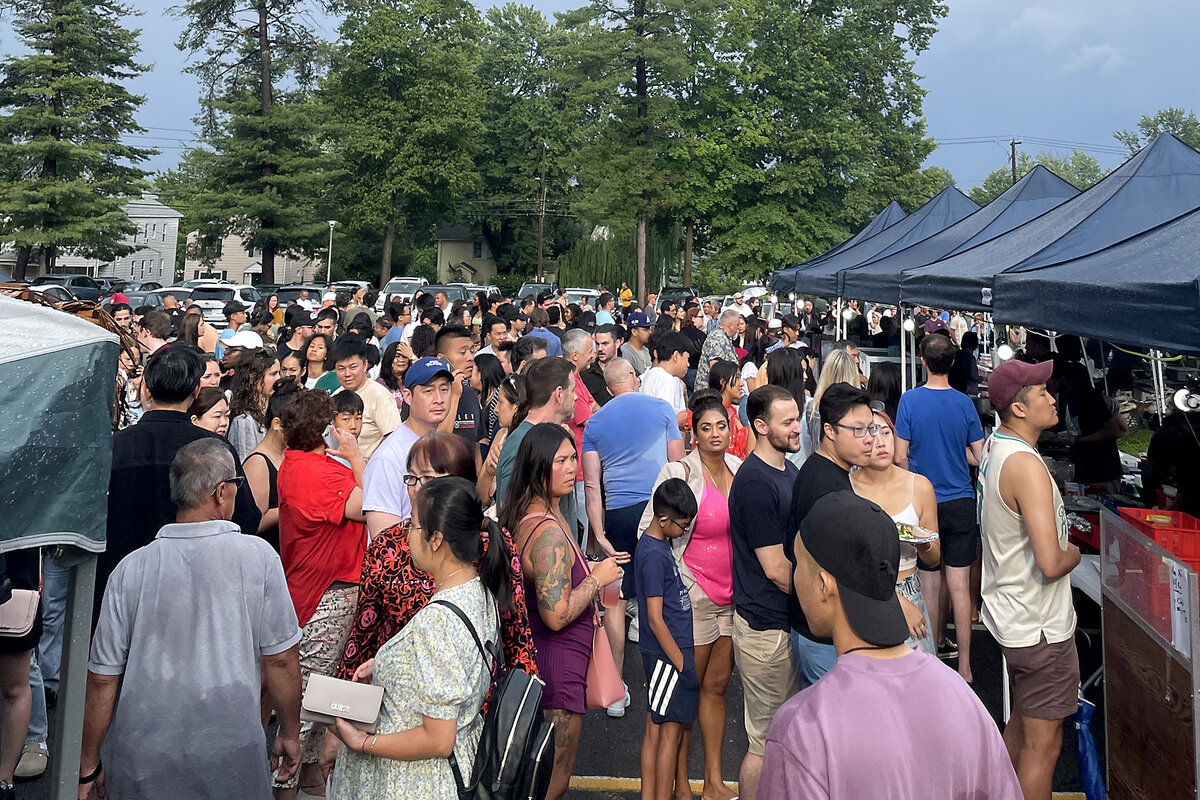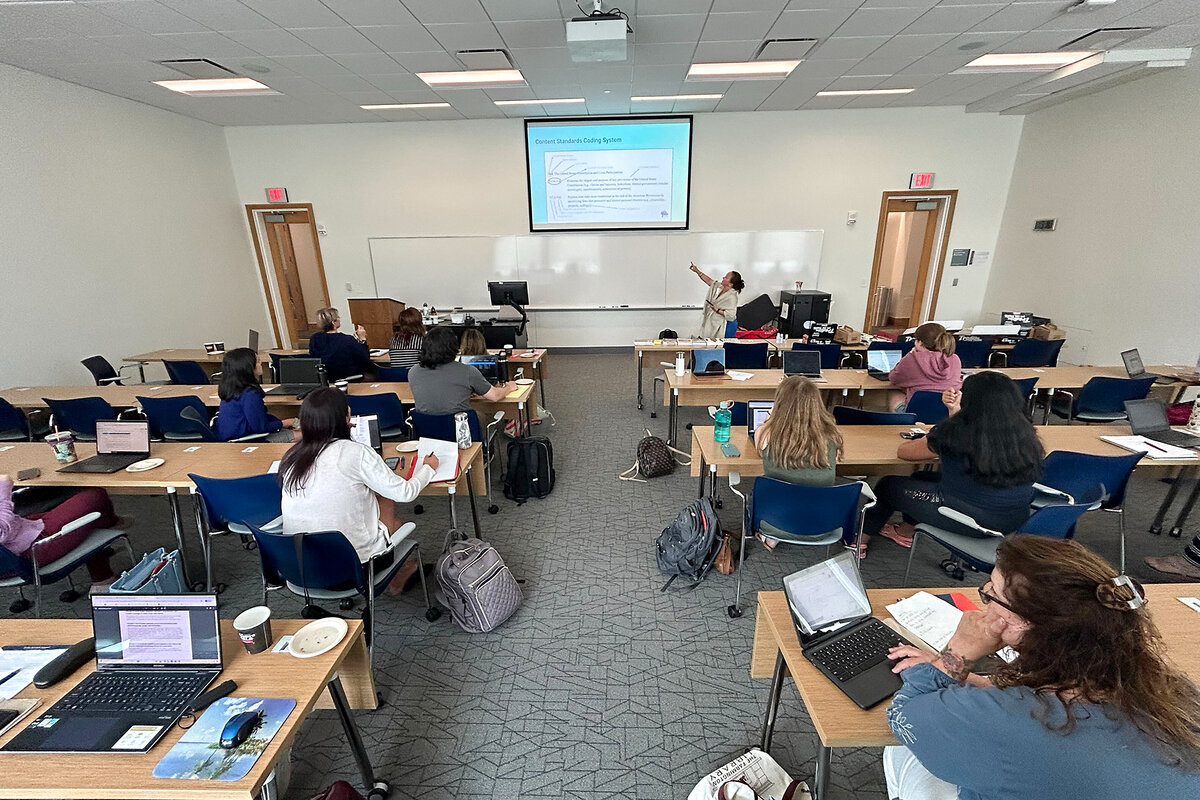Asian American history can be scarce in schools. States are trying to change that.
Loading...
| WEST HARTFORD, CONN.
As students return to U.S. classrooms this fall, a quiet revolution is underway. More states have passed laws to teach Asian American and Pacific Islander (AAPI) history in public schools.
In July, Delaware became the latest state to pass such a mandate, joining Connecticut, Illinois, New Jersey, Rhode Island, Florida, and Wisconsin. A rise in hate crimes in the United States has offered urgency to the education mission.
Why We Wrote This
A story focused onWhat should students in the United States learn about Asian and Asian American culture and history? With hate crimes on the rise, more states are turning to classroom lessons to help foster tolerance and understanding.
In Connecticut, where the AAPI population has surged by 31% in the past decade, the push to include Asian American history is not just about education – it’s also about being neighborly.
“It’s time we finally learn to understand each other,” says Laura Buffi. The high school teacher was one of a dozen attendees at the University of Connecticut’s Asian and Asian American Studies Curriculum Lab for K-12 teachers in July, the first of its kind in the state.
In the coming year, she hopes to deepen her ties with local AAPI community organizations by organizing field trips and inviting more speakers into her classroom.
“This is what we do,” she says. “We are here to help our students grow.”
At a night market in West Hartford, the smells of Vietnamese street food waft through the air, drawing the community into the open. Families descend on the cultural hub, eating together around folding tables with plastic chairs.
Laura Buffi had never attended the bazaar, but plans to bring her high school students back for a field trip. It’s the first night of the University of Connecticut’s Asian and Asian American Studies Curriculum Lab for K-12 teachers, and food is making it simpler to bridge cultural divides.
“It’s time we finally learn to understand each other,” says Ms. Buffi, one of a dozen attendees at the lab held in July, the first of its kind in the state.
Why We Wrote This
A story focused onWhat should students in the United States learn about Asian and Asian American culture and history? With hate crimes on the rise, more states are turning to classroom lessons to help foster tolerance and understanding.
As students return to classrooms in the United States, a quiet revolution is underway. More states nationwide have passed laws to teach Asian American and Pacific Islander (AAPI) history in public schools. In July, Delaware became the latest state to pass such a mandate, joining Connecticut, Illinois, New Jersey, Rhode Island, Florida, and Wisconsin.
In Connecticut, where the AAPI population has surged by more than 31% in the past decade, the push to include Asian American history is not just about education – it’s also about being neighborly.
“These changes bring us all together to create and foster more understanding,” says Swaranjit Singh Khalsa a Norwich, Connecticut, councilman who contributed to the passage of his state’s mandate. “The curriculum is not only going to educate our kids but our teachers, our professors, and our parents. So I think we are creating a much more educated society. It’s not just limited to schools.”
Asian Americans and Pacific Islanders make up one of the fastest-growing populations in the U.S. Yet their longstanding history in America is largely omitted from the classroom, says Jason Chang, director of the Asian and Asian American Studies Institute at the University of Connecticut and a co-founder of the state’s first Make Us Visible chapter.
His department at the university organized the July curriculum lab, where teachers connected with community leaders and representatives, who trained the teachers on their history, culture, and misconceptions.
“The goal was to give teachers more first hand experience and give some visibility for communities that are underrepresented,” says Mr. Chang. “We wanted teachers to ground the inquiries that they’re bringing into the classroom with experience beyond their formal education.”
Some 18 states had no content on Asians in their K-12 history curriculum standards, a national study published in 2022 found.
When textbooks did include parts of AAPI history, according to the study, by Kennesaw State University Professor Sohyun An, it was mainly about the U.S. internment of Japanese Americans during World War II, or the Chinese Exclusion Act in the 19th century. Yet 22 million Asian Americans trace their roots to more than 20 countries, according to Pew Research Center.
“It’s sad enough that our Asian students don’t have teachers or staff members who look like them. The texts we use don’t even mention them,” says Regina Gatmaitan, one of the few Filipino teachers in her district in Manchester, Connecticut, and a participant in the curriculum lab.
At least students’ learning materials can reflect their stories and cultures, she explains. “We need to teach Asian American history and stories because they’re vital,” she adds. Not doing so is “a disservice to everyone – not just the Asian community, but all communities.”
How have hate crimes influenced what’s taught in schools?
A rise in hate crimes has offered urgency to the education mission. In 2021, anti-Asian hate crimes increased by 339% over the previous year, according to the Center for the Study of Hate and Extremism. Nearly 11,000 incidents were self-reported, mostly by women, to the organization Stop AAPI Hate between 2020 and 2022.
Nearly 1 in 3 Asian Americans reported that they had been called a racial or ethnic slur in the prior year in The Asian American Foundation’s annual Social Tracking of Asian Americans in the United States Index, released in May. Nearly 3 in 10 Asian Americans reported they were verbally harassed or abused during the previous 12 months because of their race, ethnicity, or religion.
As incidents have increased, more states have begun mandating that Asian American history be taught in kindergarten through 12th grade. In 2021, Illinois became the very first state with the Teaching Equitable Asian American Community History Act. After Gov. J.B. Pritzker signed it into law, coalitions, such as Make Us Visible Connecticut and Make Us Visible New Jersey, successfully launched campaigns pushing for legislation in their states.
Educators and advocates say the current teaching mandates are underfunded. In Rhode Island, the law outlined a September 2023 rollout, “however, it provided no funding for the curriculum and left school districts to fend for themselves,” says Jeannie Salomon, founder and director of the Cultural Society for Entrepreneurship, Bilingualism, Resources and Inspirations, which is leading Rhode Island’s local efforts to teach AAPI history.
The University of Connecticut’s Asian and Asian American Studies Institute partnered with The Asian American Foundation to develop a state model curriculum for their state’s implementation of AAPI history in 2025.
“Foundations cannot do this work in perpetuity,” says the foundation’s education officer Terry Park. “We need federal and state governments to commit the necessary funding and other forms of support to ensure these mandates are fully implemented.”
New lessons for a new school year
As schools reopen, teachers say that connecting students with the AAPI community should be woven into subjects other than history and extend beyond the classroom.
Ms. Gatmaitan will be teaching sixth grade social studies and life sciences this fall. She plans to connect her lessons to the contributions of AAPI scientists. “I’m looking forward to seeing young people realize that their peers come from a rich heritage and that we can celebrate that together,” she says.
In the past, after hearing from parents that their children had never had a teacher who looked like them, Ms. Gatmaitan started bringing in fairy tales from Asian perspectives for her students in third grade – like Cinderella’s rags-to-riches story, but told through the lens of Hmong, Chinese, or Korean families.
Ms. Buffi hopes to deepen her ties with local AAPI community groups by planning field trips to cultural centers, such as a Sikh art gallery, and inviting more speakers into her classroom.
“This is what we do,” she says. “We are here to help our students grow.”










